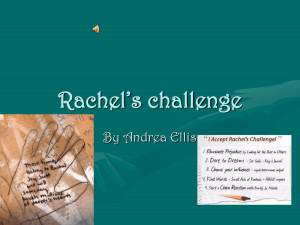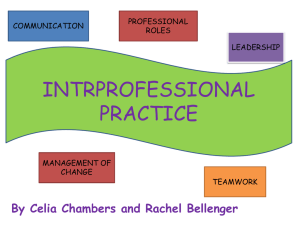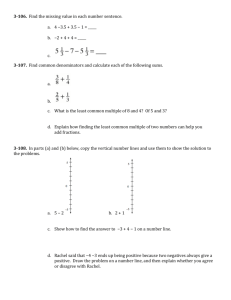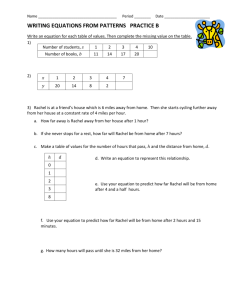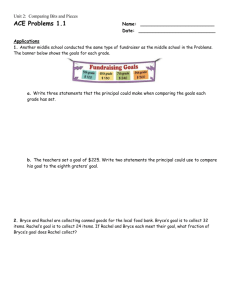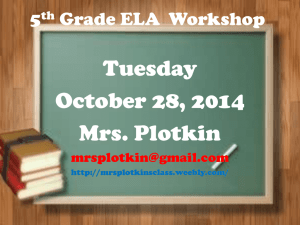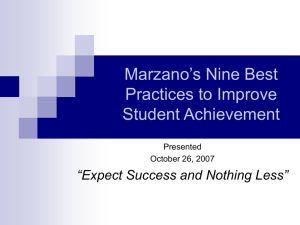Rachel Functional Vision Learning Media
advertisement
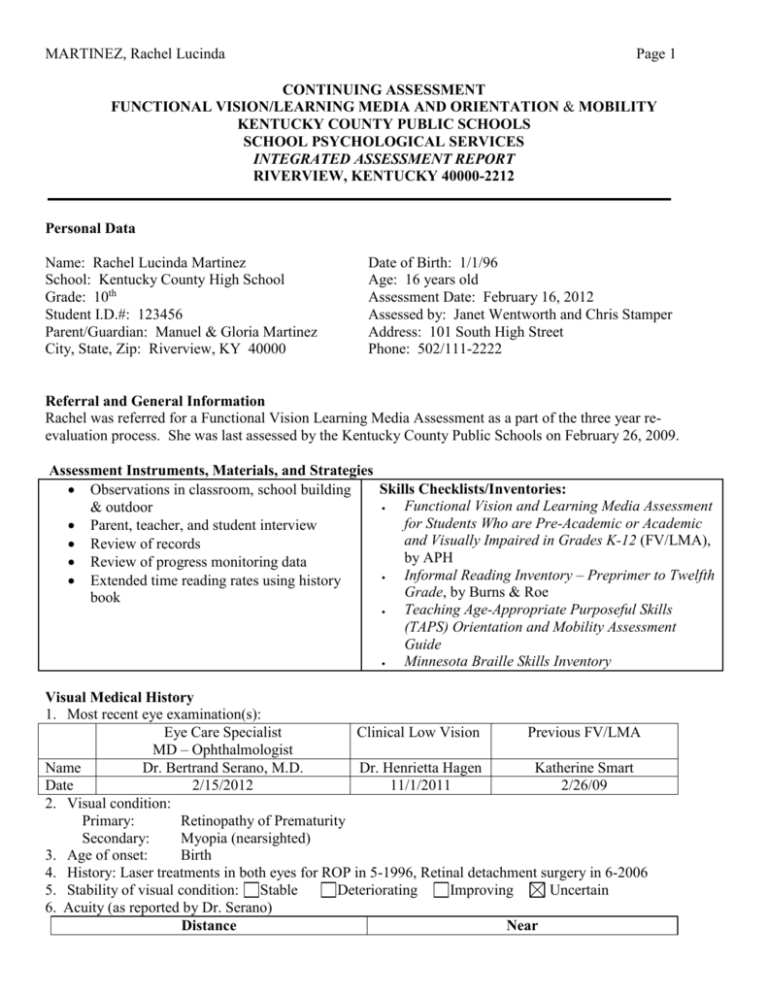
MARTINEZ, Rachel Lucinda Page 1 CONTINUING ASSESSMENT FUNCTIONAL VISION/LEARNING MEDIA AND ORIENTATION & MOBILITY KENTUCKY COUNTY PUBLIC SCHOOLS SCHOOL PSYCHOLOGICAL SERVICES INTEGRATED ASSESSMENT REPORT RIVERVIEW, KENTUCKY 40000-2212 Personal Data Name: Rachel Lucinda Martinez School: Kentucky County High School Grade: 10th Student I.D.#: 123456 Parent/Guardian: Manuel & Gloria Martinez City, State, Zip: Riverview, KY 40000 Date of Birth: 1/1/96 Age: 16 years old Assessment Date: February 16, 2012 Assessed by: Janet Wentworth and Chris Stamper Address: 101 South High Street Phone: 502/111-2222 Referral and General Information Rachel was referred for a Functional Vision Learning Media Assessment as a part of the three year reevaluation process. She was last assessed by the Kentucky County Public Schools on February 26, 2009. Assessment Instruments, Materials, and Strategies Skills Checklists/Inventories: Observations in classroom, school building Functional Vision and Learning Media Assessment & outdoor for Students Who are Pre-Academic or Academic Parent, teacher, and student interview and Visually Impaired in Grades K-12 (FV/LMA), Review of records by APH Review of progress monitoring data Informal Reading Inventory – Preprimer to Twelfth Extended time reading rates using history Grade, by Burns & Roe book Teaching Age-Appropriate Purposeful Skills (TAPS) Orientation and Mobility Assessment Guide Minnesota Braille Skills Inventory Visual Medical History 1. Most recent eye examination(s): Eye Care Specialist Clinical Low Vision Previous FV/LMA MD – Ophthalmologist Name Dr. Bertrand Serano, M.D. Dr. Henrietta Hagen Katherine Smart Date 2/15/2012 11/1/2011 2/26/09 2. Visual condition: Primary: Retinopathy of Prematurity Secondary: Myopia (nearsighted) 3. Age of onset: Birth 4. History: Laser treatments in both eyes for ROP in 5-1996, Retinal detachment surgery in 6-2006 5. Stability of visual condition: Stable Deteriorating Improving Uncertain 6. Acuity (as reported by Dr. Serano) Distance Near MARTINEZ, Rachel Lucinda Without With With Low Without Correction Correction Vision Device Correction OD: OD: 20/400 OD: OD: OS: OS: 20/200 OS: OS: OU: OU: OU: OU: OD = Right Eye OS = Left Eye OU = Both Eyes Page 2 With Correction OD: OS: OU: With Low Vision Device OD: OS: OU: 7. Visual fields: Constricted field: approximately 70-80 degrees with both eyes. 8. Doctor checked Legally Blind 9. Prescription lenses: Sph. Cyl. Axis OD -4.50 +8.50 090 OS -5.00 +8.50 090 Date prescribed: 2/2012 10. Other references to visual functioning: Dr. Serano recommended Rachel sit in front of class, use large print on an as needed basis, be re-examined in one year, wear her glasses constantly, and use average lighting. Physical activity is restricted as vision allows. 11. Medications: None noted Explanation of Visual Conditions and Their Implications Retinopathy of Prematurity (ROP) is a curtailment of retinal blood vessel development in premature infants which can lead to bleeding, scarring, and retinal detachment. ROP can range from minimal damage to complete blindness. Possible implications include decreased visual acuity, severe myopia, and retinal detachment. Precautions should be taken to prevent retinal detachments, such as, things moving from the side towards her, fast moving balls, or any blows to the head or eyes. Myopia is a refractive error where the image of a distant object is formed in front of the retina and cannot be seen distinctly resulting in the inability to see at distances. Near vision is rarely affected. A student may need to move closer to see the board or classroom demonstrations. Visual Functioning Results Functional vision is how well a student uses visual information in performing daily activities in a variety of settings. A Functional Vision and Learning Media Assessment (FVLMA) determines how a student functions visually in daily activities with a variety of materials, explores ways to increase visual functioning, determines or reviews the student’s primary and secondary learning media, identifies current skills in literacy instruction, and ascertains how the visual impairment adversely affects the student’s educational performance. Appearance of the Eyes and Mannerisms Rachel experienced a retinal detachment in her right eye at age 10, including some retinal scarring; however the scarring does not seem to affect her visual viewing. She does not exhibit behavioral abnormalities or mannerisms associated with her vision. Rachel wears prescription glasses all day and keeps them clean with a cloth carried in her purse. Near and Distant Vision She can read 12-14 point standard print, bold, black, isolated letters on a white background at a distance of 4-6 inches for short reading passages, and she prefers larger print (16-18 point type) for worksheets and handouts. MARTINEZ, Rachel Lucinda Page 3 Rachel can identify large objects at distances up to 10 feet away. She uses a 6x16 monocular for spotting information such as reading a clock, classroom numbers, bulletin boards and other signage. She can copy 2-3 inch size letters from the board when sitting at a distance of 10 feet or less. Given her limited visual field, Rachel prefers to sit on the right side of the room when copying material from the board. Even though Rachel can read and use color-coded graphs and maps, she prefers the use of black or blue print for distant visual instruction and models. Learning and Literacy Media Assessment Results A learning and literacy media assessment determines how a student accesses or may need to learn to access printed information. Information in print may be accessed visually, tactually (Braille), auditorily or a combination of any of these methods. Reading Efficiency Rachel can read a variety of print media, such as most class handouts and maps, if the contrast is clear and distinct. Materials with small print, cluttered information, and/or low contrast results in visual fatigue and errors. The average silent reading rate for 10th grade students with normal vision is 210-224 words per minute (wpm). However, she reads at a rate of 115 wpm on a 10th grade level passage when using large print. Rachel has a history of visual fatigue given lengthy reading periods of greater than 20 minutes. For this reason, she needs frequent 1-2 minute breaks and extended time to complete her work. Rachel may choose an auditory output of the text in the event of lengthy reading assignment. Literacy Tools Rachel uses a bar magnifier, video hand-held magnifier or desktop closed-circuit television (CCTV) if print is smaller than the 12 point type or when using a graphing calculator. She performs at a 10th grade level on an informal listening comprehension assessment, and utilizes auditory output for lengthy materials or when fatigued. For classroom use, Rachel uses bold-lined notebook and graph paper. She also uses models and manipulatives and real life items to understand math concepts. Braille Due to an uncertain prognosis of her eye condition, Rachel receives Braille reading and writing instruction. She demonstrates good tactual discrimination of Braille cells and is proficient with the use of the Braille writer. According to the Minnesota Braille Skills Inventory, Rachel can read and write 26/26 letters and whole word signs (100%), 40/76 short form words (or 53%), and 15/30 (or 50%) of part word signs in Literary Braille. For instructional purposes, Rachel would rather use self-selected Braille passages. Expanded Core Curriculum The Expanded Core Curriculum (ECC) is skills and knowledge that are needed by students with visual impairments due to their disability-specific needs. Students with visual impairments need the expanded core curriculum in addition to the core academic curriculum of general education. 1. Compensatory or Functional Academic Skills, Including Communication Modes Rachel organizes her school work and can usually find her assignments upon request. Rachel’s handwriting is legible to herself and others. She writes her signature using a typoscope. Rachel works well in a group, and prefers to complete independent tasks in a quiet environment. She makes average to above average grades in all core content areas except for math. Rachel struggles to reason abstractly and quantitatively. Students with low visual acuity frequently have difficulty with these skills due to limited obtainment of visual concepts. She also has difficulty visualizing complete math expressions in their entireties. Instead, she focuses on small segments of a problem rather than the whole. Due to low visual acuity Rachel must view materials at a close proximity resulting in difficulty retaining information necessary for solving math problems. MARTINEZ, Rachel Lucinda Page 4 See Learning and Literacy Media Assessment above for information on Braille instruction. 2. Orientation & Mobility Orientation and mobility instruction is age-appropriate ongoing training which teaches students with visual impairments to move safely and efficiently in their home, school, work, and/or community settings as independently as possible. Mrs. Martinez reported that the family lives in a residential area with sidewalks. She stated that Rachel has difficulty with depth perception and is frightened when using an escalator while shopping with friends at the mall. She would like for Rachel to be more aware of her surroundings, to be able to travel around the city on a bus, and to become more independent when traveling in unfamiliar locations. Rachel’s parents are very concerned about her well-being and safety. Mrs. Martinez stated that she tends to be more protective with Rachel than her other children. Rachel’s teacher reported that Rachel was able to independently find her classes when travel within the school. When walking in a crowded hallway, she could negotiate around other students and keep a good distance when traveling from class to class. An observation was conducted on February 4, 2012, by Chris Stamper, Certified Orientation and Mobility Specialist (COMS). Rachel traveled using her long white cane and was able to travel down hallways independently. She was able to maintain a straight line of travel and safely maneuvered around obstacles within her travel path. Rachel was traveling outside during a sunny day in an unfamiliar residential area. Rachel demonstrated that she understood cardinal directions and knew what street she had to cross in order to reverse the route. Rachel showed that she stayed in step when traveling which meant that she was able to get adequate coverage needed for traveling with a cane safely. She was able to maintain orientation of an L shape and U shape routes within her neighborhood. Rachel distinguished changes in textures and surface elevations using her long white cane by detecting all drop-offs and curbs that she encountered when traveling. She followed multi-step directions and read street signs that were within 10 feet. She located house numbers on the same side of the street using her monocular, but she was not always able to read the numbers. She was unfamiliar with the city’s numbering system; therefore she was unable to determine the numbers of the houses that she could not see. Progress monitoring data indicates that Rachel can problem solve in some travel situations. She describes and makes safe and independent street crossings at traffic lights with 80% based on 10 trials. She is starting to route plan utilizing the city’s numbering system (20 % accuracy). Further, she has been recently introduced to map reading (20% accuracy). She has limited experience riding public transportation and crossing streets at complex lighted intersections. 3. Social Interaction Skills Rachel easily develops relationships with teachers and peers. She is well liked and has a close group of female peers. She participates in after school activities and is on the year book committee at school. Rachel participates in church related activities including overnight retreats. Rachel speaks Spanish at home and with her peers from church. 4. Independent Living Skills While Rachel has a high school identification card, she does not have a state identification card which is needed for the future. Rachel and Ms. Martinez describe age appropriate table manners (home and restaurants), personal hygiene and grooming. Chores in the home include dishes, simple meal preparation, keeping her room clean, and taking out the trash. She uses a telephone (cell phone and home phone) and calendar to organize school and recreational activities. She receives an allowance and saves her money to go out with friends. She MARTINEZ, Rachel Lucinda Page 5 recognizes the onset of a migraine and seeks her mother for medication when at home or goes to the office to follow the medical procedures on file when at school. 5. Recreation and Leisure Skills Rachel is active in church functions and goes out with friends at least once weekly. Rachel enjoys writing in her journal. She has written several short stories which she hopes to publish. She enjoys listening to her radio and MP3 player. Due to her visual condition she does not play contact sports, however, she attends school basketball and football games. Rachel has a dog and is responsible for its care and feeding. 6. Career Education Rachel is unfamiliar (0% accuracy) with community and college programs that provide post-secondary supports and opportunities (e.g., volunteer opportunities, leisure activities, career exploration, work experience). She would like to pursue a career in writing and she hopes to write in the field of television or radio. Rachel attended the mandatory college fair days at her high school. She is not familiar with scholarship opportunities or funding sources. 7. Use of Assistive Technology Rachel benefits from electronic text and/or auditory output for lengthy reading assignments. Rachel demonstrates good basic computer skills using built-in accessibility features. Following keyboarding instruction in 10th grade, she prepares assignments via word processing. She types 20 words per minute. Previous data indicate proficiency in the use and maintenance of technology and equipment (100% on 5/5 occasions). She benefits from a hand held video magnifier or desktop CCTV for reading material when enlarged copies are not available. Rachel is a proficient user of the hand held video magnifier and CCTV. Rachel uses peers to read to her under time constraints or when longer passages are presented as her eyes fatigue and reading rate becomes slower. Rachel uses a scribe to transfer responses to an electronic answer sheets (bubble sheet). 8. Sensory Efficiency Skills When asked, Rachel can make decisions as to what visual device she needs and she can explain how the device functions. Rachel uses and cares for her visual devices (100% accuracy on 5/5 occasions). She is able to determine where to sit for best viewing of materials being presented in a classroom setting. She appears to have good hearing and can utilize auditory materials effectively, however, she does not ask for auditory materials independently. She has good tactual skills which she uses to discriminate the Braille cell which is evidenced by the progress she is making in learning the Braille code. 9. Self-Determination Currently, teaching staff provide all of Rachel’s educational materials. Rachel requires prompting to request adaptations in the classroom setting (3/3 occasions). She does not independently access modifications or accommodations within an environment (0% proficiency). She has limited experience accessing print or auditory materials for educational purposes, such as ordering textbooks from clearing houses or publishers (0% proficiency). Rachel does not inform others about her eye condition and deflects questions about adaptive equipment. Rachel has attended ARC meetings since 7th grade. She responds to questions but does not initiate the identification of needs nor advocate for herself. Summary of Major Findings Rachel is a 10th grade student attending Kentucky County High School. Rachel was referred for a reevaluation to determine if she continues to meet eligibility for a visual impairment and to assist in planning for Rachel’s educational needs. The eye medical report indicates that Rachel meets the definition of legal blindness due to her corrected distant visual acuity and restricted field of view. Rachel’s primary mode of learning is print, however, she functions more effectively with large print and/or auditory output. She has been prescribed low MARTINEZ, Rachel Lucinda Page 6 vision devices and uses them effectively when prompted. Rachel reads 115 words per minute which is well below her same grade peers with normal vision. She can use a variety of accommodations to meet her visual needs and accesses the accommodations when prompted. She is learning Braille as a secondary medium given her uncertain visual prognosis and eye fatigue. Results of this evaluation indicate that Rachel has instructional needs in the following Expanded Core Curriculum areas: Compensatory or Functional Academic Skills, Orientation & Mobility, Career Education, Assistive Technology, Sensory Efficiency, and Self-Determination. The Admission and Release Committee should consider information prepared in this report as one component of the total assessment. Members of this committee must consider all relevant data presented in the meeting before making eligibility or programming decisions. Suggested Educational Strategies Provide copies of syllabus and reading assignments ready 1-2 weeks prior to the lesson so documents are available for auditory presentation or adaptation for large print. Pace the presentation of a lesson. If referring to a text book or handout, allow time for Rachel to find the information. Repeat aloud what is printed on the board, presented on overheads/whiteboards or handouts. Given presentation of a diagram or visual, explain the meaning of the visual. Avoid making statements that cannot be understood by a student with a visual impairment. For instance, a non-example is, “This diagram sums up what I am saying about statistics.” Given poor distant visual acuity, field restrictions and the possibility of a retinal detachment, consider precautions, such as, activities that include objects moving from the side towards her, fast moving balls, activities involving potential blows to the head or eyes (see Eye Medical Report for details). Use of blue or black print on white board presentations. Ensure preferential seating on right side of the classroom and within 10 feet during presentations. Provide a scribe for electronic answer sheets (bubble sheet). Provide extended time for testing and assignments with substantial reading requirements. Provide periodic breaks for eye fatigue. Promote independence across settings in regards to materials and resources. Suggested Materials and Equipment Large print (prefers 16-18 point) with high contrast (yellow overlay or typoscope) Bold-lined notebook or graph paper Electronic text/auditory material for lengthy reading or for eye fatigue Long white cane Bar magnifier, hand-held video magnifier or a desktop CCTV Report prepared by: __________________________________ Janet Wentworth Teacher of the Blind and Visually Impaired Office: 441-2020 E-mail address: janet.wentworth@kentucky.kyschools.us ___________________________________ Chris Stamper Certified Orientation & Mobility Specialist (COMS) MARTINEZ, Rachel Lucinda Office: 334-2020 E-mail address: chris.stamper@kentucky.kyschools.us Page 7
